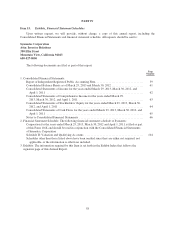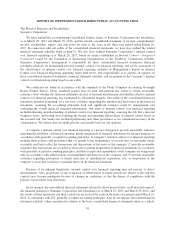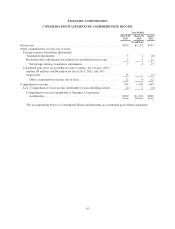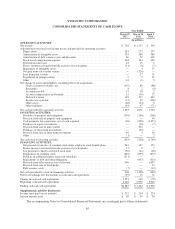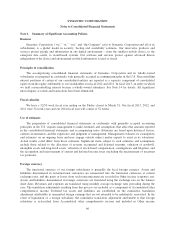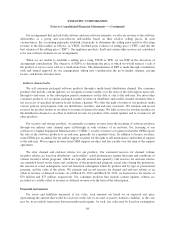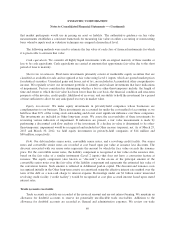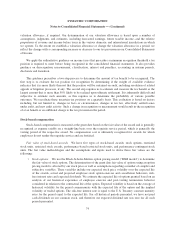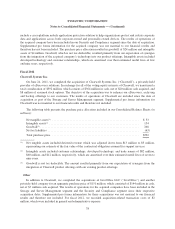Symantec 2013 Annual Report Download - page 166
Download and view the complete annual report
Please find page 166 of the 2013 Symantec annual report below. You can navigate through the pages in the report by either clicking on the pages listed below, or by using the keyword search tool below to find specific information within the annual report.SYMANTEC CORPORATION
Notes to Consolidated Financial Statements — (Continued)
For arrangements that include both software and non-software elements, we allocate revenue to the software
deliverables as a group and non-software deliverables based on their relative selling prices. In such
circumstances, the accounting principles establish a hierarchy to determine the selling price used for allocating
revenue to the deliverables as follows: (i) VSOE, (ii) third-party evidence of selling price (“TPE”) and (iii) the
best estimate of the selling price (“ESP”). Our appliance products, SaaS and certain other services are considered
to be non-software elements in our arrangements.
When we are unable to establish a selling price using VSOE or TPE, we use ESP in the allocation of
arrangement consideration. The objective of ESP is to determine the price at which we would transact a sale if
the product or service were sold on a stand-alone basis. The determination of ESP is made through consultation
with and formal approval by our management, taking into consideration the go-to-market strategy, pricing
factors, and historical transactions.
Indirect channel sales
We sell consumer packaged software products through a multi-tiered distribution channel. For consumer
products that include content updates, we recognize revenue ratably over the term of the subscription upon sell-
through to end-users, as the subscription period commences on the date of sale to the end-user. For most other
consumer products, we recognize packaged product revenue on distributor and reseller channel inventory that is
not in excess of specified inventory levels in these channels. We offer the right of return of our products under
various policies and programs with our distributors, resellers, and end-user customers. We estimate and record
reserves for product returns as an offset to revenue or deferred revenue. We fully reserve for obsolete products in
the distribution channel as an offset to deferred revenue for products with content updates and to revenue for all
other products.
For security and storage products, we generally recognize revenue from the licensing of software products
through our indirect sales channel upon sell-through or with evidence of an end-user. For licensing of our
software to Original Equipment Manufacturers (“OEMs”), royalty revenue is recognized when the OEM reports
the sale of the software products to an end-user, generally on a quarterly basis. In addition to license royalties,
some OEMs pay an annual flat fee and/or support royalties for the right to sell maintenance and technical support
to the end-user. We recognize revenue from OEM support royalties and fees ratably over the term of the support
agreement.
We offer channel and end-user rebates for our products. Our estimated reserves for channel volume
incentive rebates are based on distributors’ and resellers’ actual performance against the terms and conditions of
volume incentive rebate programs, which are typically entered into quarterly. Our reserves for end-user rebates
are estimated based on the terms and conditions of the promotional program, actual sales during the promotion,
the amount of actual redemptions received, historical redemption trends by product and by type of promotional
program, and the value of the rebate. We estimate and record reserves for channel and end-user rebates as an
offset to revenue or deferred revenue. As of March 29, 2013 and March 30, 2012, we had reserves for rebates of
$79 million and $73 million, respectively. For consumer products that include content updates, rebates are
recorded as a ratable offset to revenue or deferred revenue over the term of the subscription.
Financial instruments
For assets and liabilities measured at fair value, such amounts are based on an expected exit price
representing the amount that would be received on the sale of an asset or paid to transfer a liability, as the case
may be, in an orderly transaction between market participants. As such, fair value may be based on assumptions
68


